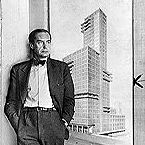Gropius was born in Berlin, Germany on May 18, 1883.
He joined the office of Peter Behrens, whom was one of his biggest influences, in 1907 and worked there until 1910. He was also influenced by Le Corbusier and Mies van der Rohe and often collaborated with Marcel Breuer.
Marriage with Alma Mahler.
In 1911 he became a member of the German Labour League (Deutscher Werkbund) which was founded to ally creative designers with machine production. The group was against imitation and weary of the simple theory that followed function.
The Fagus plant from 1911
In 1919 Gropius became the director of the Grand Ducal Saxon School of Arts, and Crafts Academy of Arts and School of Arts; which were all united as Staatliches Bauhaus Weimar. Bauhaus being "house for building"; the schools motto was "Art and Technology the New Unity" Gropius introduced a new approach to design education in joining art and industry. The general requirement for all students was a rigorous study in practical crafts training. It wa this approach and his techniques that would allow Gropius to become know as "the great organizer." He wrote several articles such as "The development of Modern Industrial Architecture" in 1913 and "Idee und Aufbau" (Idea and Construction) in 1923.
The Bauhaus curriculum included study in stone, wood, metal, clay, glass, pigments, and textile looms. The program combined the study of nature, materials, geometry, construction, drawing, color and composition. In 1928 he resigned from the Bauhaus; Hannes Meyer took over until 1930 at which time Gropius recommended Mies van der Rohe take over.
In 1937 he brought he teaching abilities to Harvard University where he would teach such students as I.M Pei, Paul Rudolph, and Philip Johnson as professor of Architecture. He invited his friend Marcel Breuer to come and teach at Harvard also. He would become the chairman of the Architectural department until 1952 when he retired. While at Harvard he and several students formed TAC The Architects Collaborative in 1946. Gropius believed the duty of the architect was to encompass a total visual environment. He also had a strong belief that architects should work in partnerships. His dogma that every design; chair, house, city, etc; should be don through the same processes; through systematic study of the particular needs and problems involved. Taking in to account modern materials and techniques without reference to previous forms or styles. He sought intellectual solutions of larger socially urgent problems and attempted to bridge the gap between business, technology, and the imagination of a creative designer. He designed railcars, locomotives, and deluxe automobiles among other things. He created works of simple geometry, often rectangles of varying size which would signify a hierarchy.
These forms were marked by smooth surfaces, primary colors, and modern materials such as steel and glass. With both linear and horizontal elements Gropius introduced strength, stability and dynamics. His designs are pure and clean and the volumes and planes were often accentuated by light according to function; he paid great attention to these such details. The window was seen as an important tool; a window flush with the facade reinforces the overall volumetric character of the space within, while a window recessed accentuates the hovering floor planes. Through a study of lighting angles and plot ratios Gropius assured himself a stable site. "We amassed such a tremendous arsenal of techniques that their bristling display has nearly robbed us of our sense of balance. Our cities have taken on the look of a free-for-all, wild competition to engage mind, heart and body of its populace." With the basic unity of all creative work Gropius changed the way architecture is taught. He was a great architect; however he is more influential as an educator an author as he was a natural teacher and a great leader. One of his best lessons can be seen through his writing "New times demand their own expression. Exactly stamped form devoid of all accident, clear contrast. The ordering of members the arrangement of like parts in series, unity of form colour an appropriate style reliant on economics an human life."
Foto: Karolinsky-Archive
